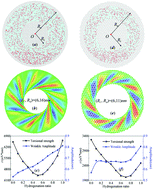Tunable in-plane torsional strength of surface functionalized two dimensional nanomaterials†
Abstract
In this paper, the in-plane torsional properties of two dimensional nanomaterials are revealed to be tunable by surface functionalization using molecular dynamics simulations. The torsional strengths of both graphene and graphyne under circular shearing are found to first decrease and then increase anomalously with the increase of the hydrogenation ratio. The minimum strength of such U-shaped strength evolution appears at different hydrogenation ratios H for graphene (H = 50%) and graphyne (H = 70%), demonstrating a correlation between hydrogenation and the unit lattices of 2D nanomaterials. By studying the torsional characteristics of a graphene annulus with varying outer-to-inner boundary radius ratios, the anomalous increase of torsional strength at a high hydrogenation ratio is revealed to be the result of wrinkling deformation as well as chemical bond hybridization. Further analyses of the local stress distribution are carried out for understanding the mechanism of surface hydrogenation tuned in-plane torsional strength of graphene and graphyne. Torsional strength of the graphene annulus with an elliptical outer boundary also shows a U-shaped evolution with hydrogenation ratio, while the shape effect of the graphene annulus can smooth the change of the torsional characteristics with hydrogenation. Our results provide novel insights into the development of 2D nanomaterial-based annular devices.



 Please wait while we load your content...
Please wait while we load your content...